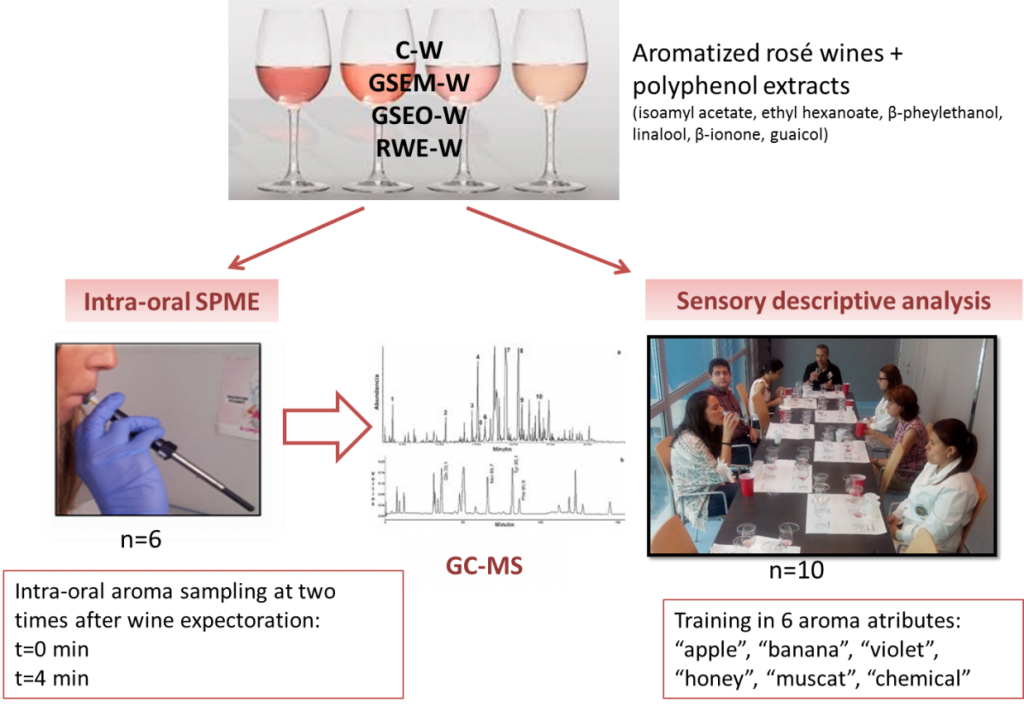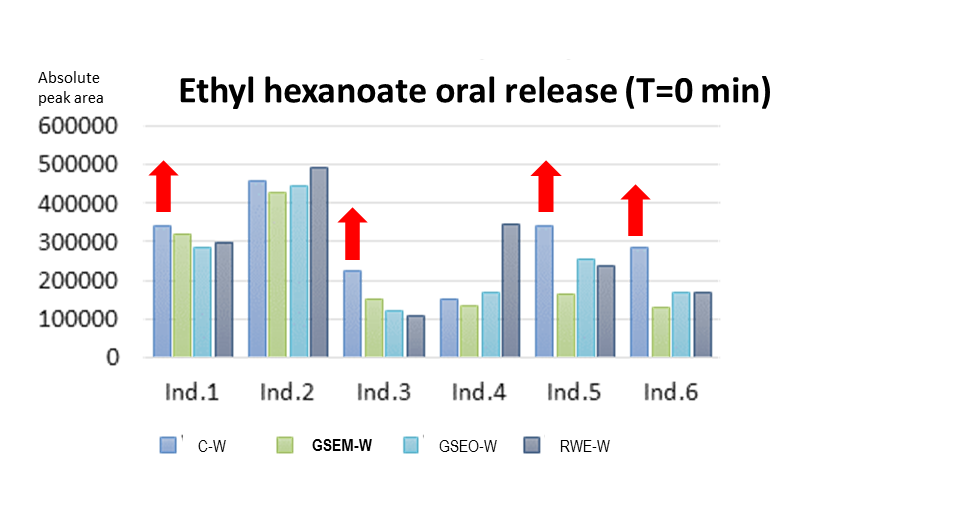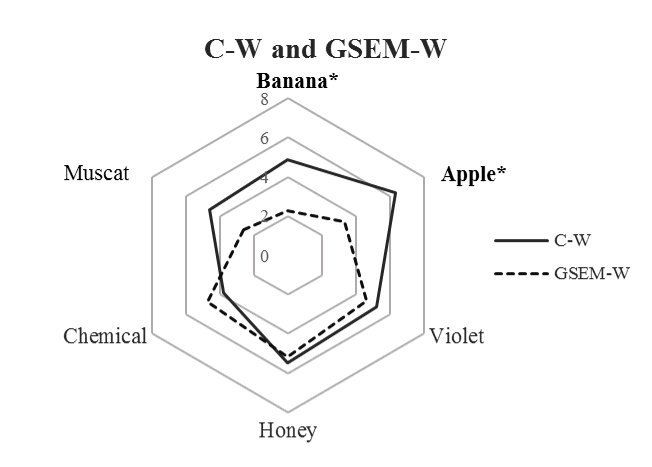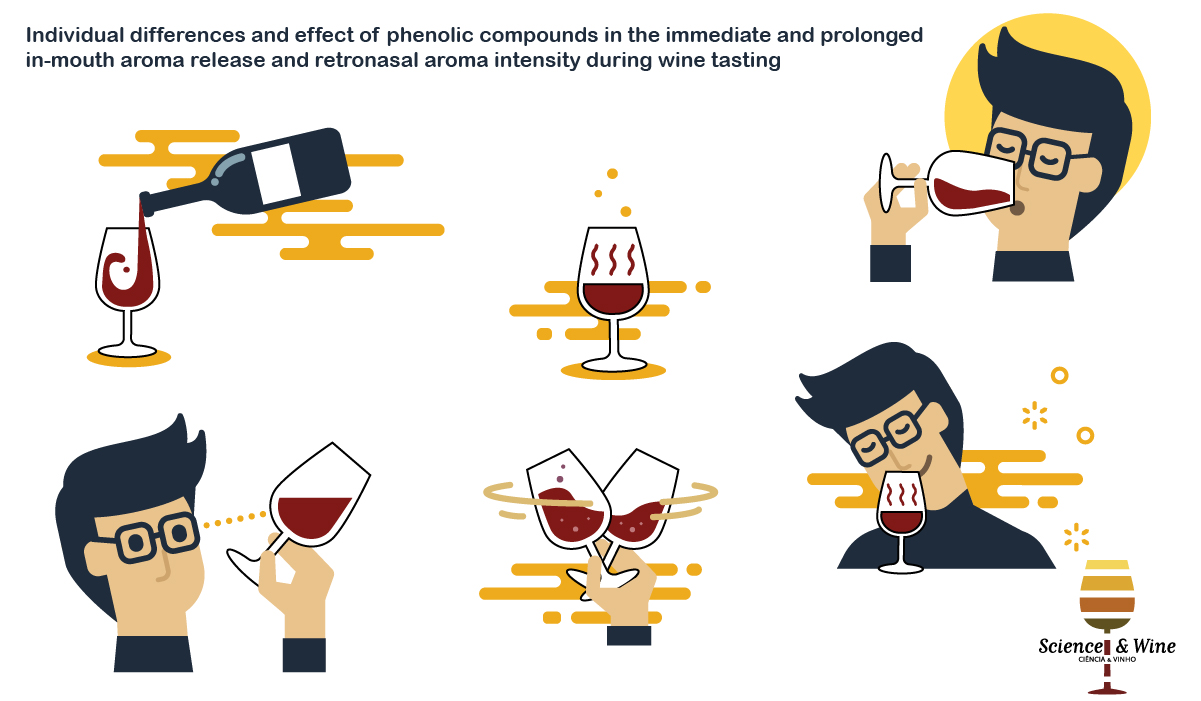By Maria Angeles del Pozo Bayón
Phenolic compounds cover the largest fraction of the non-volatile components of wines. Flavonoids (flavonols, anthocyanins and flavan 3-ols) and non-flavonoids (phenolic acids and stilbenes) are the two major classes of wine phenolics. Among them, flavan-3-ols monomers and their oligomers and polymers, which are called proanthocyanidins or condensed tannins, are the most abundant in wine. These compounds have a large contribution to wine sensory characteristics, such as color, astringency and bitterness.
However, phenolic compounds can also affect wine aroma since they can interact with different types of aroma molecules, changing their volatility and modifying aroma release (Pozo-Bayón & Reineccius, 2009). There are many analytical studies focused on determining aroma-phenolic interactions at the molecular level. Most of these works have been conducted using –in vitro approaches (static and dynamic headspace conditions), which although very valuable in determining the chemical nature of aroma-phenolic interactions, do not represent the retronasal delivery of odorants during wine tasting.
In fact, when the wine is introduced into the oral cavity, it is submitted to oral processing. Once in the mouth, wine components (aromatic and nonaromatic compounds) and oral fluids and structures (e.g. saliva, oral mucosa) act together, determining aroma release patterns (Pozo-Bayón, Muñoz-González, & Esteban-Fernández, 2016). However, the chemical and biochemical changes of these odorant compounds during wine oral processing remain scarcely investigated.
Polyphenols might affect aroma release during wine oral processing through the formation of polyphenol-saliva proteins complexes (Mitropoulou, Hatzidimitriou, & Paraskevopoulou, 2011) modifying the transfer of aroma compounds to the exhalation flows that carry out the aromatic molecules to the olfactory receptors. The delayed aroma release from the oral/throat coatings could be behind the long lasting aroma perception (aroma persistence) closely related with wine quality. Therefore, saliva composition might affect this process.
In a recent work (Pérez-Jiménez et al. 2019) we have explore the role of phenolic compounds on oral aroma release during wine tasting, considering the individual effect and establishing whether this effect might also have consequences on aroma perception. In this study, the same rosé wine was supplemented with three types of commercial phenolic extracts. Two of them composed of rich monomers (GSEM-W) and oligomers (GSEO-W) purified fractions obtained from a grape seed extract, and the third one, a red wine extract (RWE-W) mainly composed of anthocyanins. All the wines were aromatized with a target mixture of six wine typical aroma compounds with different physicochemical properties. Oral aroma release was monitored in six volunteers by means of intra-oral SPME at two different times after wine rinsing, just after spiting off the wines (immediate aroma release) and four minutes later (prolonged aroma release). In addition, the sensory meaning of this effect was assessed using a trained panel (n=10) in the recognition and retronasal evaluation of the aromatic descriptors associated to the odorant molecules used to aromatize the wines. An overview of the work can be seen in figure 1.

Results showed a strong individual effect on total oral aroma release at the two sampling points (t=0 and t=4 minutes after wine expectoration). The first oral aroma monitoring could be more related to the immediate aroma release from oral mucosa, while the second one could be linked to the delayed release, or aroma persistence. These differences on aroma release can be linked to differences in saliva composition. For instance, as it is shown in the results from the principal component analysis (PCA), some aroma compounds (linalool, β-ionone and β-phenylethanol) were highly correlated with saliva total protein content and saliva flow (Figure 2). Individual #4 showed a high oral release of the above mentioned aroma compounds as compared to the rest. This could be related to his saliva composition. This individual had the highest concentration of saliva proteins (2700 µg/mL) and the lowest saliva flow (0.36 mL/min). As lower the salivary flow, lower dilution of aroma compounds and therefore, more aroma compounds will be available to be released to the exhalation flows. On the contrary, the highest saliva protein content of this individual might have affected the retention of aroma compounds, and mainly esters, by saliva proteins through noncovalent interactions has been described (Friel & Taylor, 2001).

Regarding the effect of phenolic extracts, a general decrease in aroma release after the oral exposure to wines with all phenolic extracts was observed. However this effect was dependent on individual. This happened for all six aroma compounds in individuals #5 and #6, for five compounds in the case of individual #3, and for three compounds in the case of individuals #1 and #4.This situation was very similar in the second monitoring time, in which phenolic compounds also decreased oral aroma release. An example of the effect of phenolic extracts on the oral release of ethyl hexanoate is shown in figure 3. Four minutes after spitting-off the wines, the effect of phenolic extracts was also significant for many aroma compounds, and especially for the two esters, isoamyl acetate and ethyl hexanoate.
Results from the sensory analysis confirmed that wines with phenolic extracts even at the very low dose like that used in this study (150 mg/L), exhibited significantly lower intensity for the attributes “banana” and “apple” which were associated with the compounds isoamyl acetate and ethyl hexanoate (Figure 4). These compounds were also lower oral released, confirming the good agreement between the -in vivo analytical approach using intra-oral SPME and the sensory findings, at least for these chemical odorants (ester compounds).

Overall, from a technological point of view this study provides new insights for the development and/or improvement of polyphenol base oenological formulations to enhance wine aroma persistence.
More information about this work can be found in the original article:
Perez-Jiménez, M., Chaya, C., & Pozo-Bayón, M. Á. (2019). Individual differences and effect of phenolic compounds in the immediate and prolonged in-mouth aroma release and retronasal aroma intensity during wine tasting. Food Chemistry. Volume 285, Pages 147-155

Those interested in a longer length report can download the working paper at:
https://www.sciencedirect.com/science/article/pii/S0308814619302274

Maria Angeles del Pozo Bayón
Maria Angeles del Pozo Bayón is a Research Scientist at the Institute of Food Science Research (CIAL) in Madrid, which belongs to the Spanish National Research Council (CSIC). She has a graduate Degree in Biology and in Food Science and Technology. During her PhD she studied the effect of technological variables influencing important wine quality markers such as the aroma and phenolic compounds. She was granted with a Marie-Curie postdoctoral fellowship to work at the CSGA-INRA Dijon (France) in aspects related to matrix-aroma interaction and its effect on aroma release. She also was a Postdoctoral Research Associate at the Food Science and Nutrition Department in the University of Minnesota (USA), where she worked on real time aroma monitoring using PTR-MS technique. Currently she has a Tenure position at CIAL, and she is the leader of a National Project focused on investigating the effect of oral physiology on the interindividual differences on wine aroma release and aroma perception and its effect of consumer choice. Recently she has received the ENOFORUM 2018 Award “Spanish Research for Development”. She is the author of numerous publications in scientific and technical journals mainly regarding the topic of flavor chemistry.
References:
- Friel, E., & Taylor, A. (2001). Effect of salivary components on volatile partitioning from solutions. Journal of agricultural and food chemistry, 49(8), 3898-3905.
- Mitropoulou, A., Hatzidimitriou, E., & Paraskevopoulou, A. (2011). Aroma release of a model wine solution as influenced by the presence of non-volatile components. Effect of commercial tannin extracts, polysaccharides and artificial saliva. Food research international, 44(5), 1561-1570.
- Perez-Jiménez, M., Chaya, C., & Pozo-Bayón, M. Á. (2019). Individual differences and effect of phenolic compounds in the immediate and prolonged in-mouth aroma release and retronasal aroma intensity during wine tasting. Food Chemistry, 285, 147-155
- Pozo-Bayón, M. Á., & Reineccius, G. (2009). Interactions between wine matrix macro-components and aroma compounds. In Wine chemistry and biochemistry, (pp. 417-435): Springer.
- Pozo-Bayón, M. Á., Muñoz-González, C., & Esteban- Fernández, A. (2016). Wine preference and wine aroma perception. In Wine Safety, Consumer Preference, and Human Health, (pp. 139-162): Springer.

